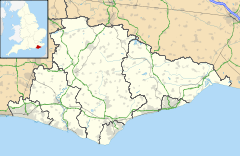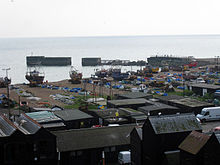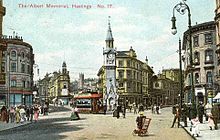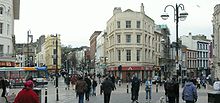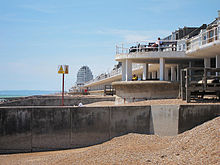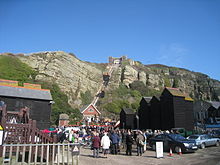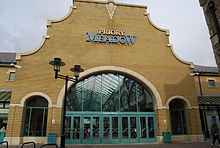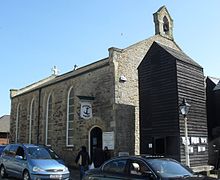- Hastings
-
Coordinates: 50°51′N 0°34′E / 50.85°N 0.57°E
Borough of Hastings Hastings 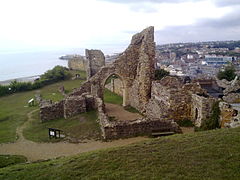
Hastings Castle, with the Pier and Town Centre in the background
Town Coat of arms
 Borough of Hastings shown within East Sussex
Borough of Hastings shown within East SussexArea 2.972 km2 (1.147 sq mi) Population 86,900 [1] - Density 29,240 /km2 (75,700 /sq mi) OS grid reference TQ8160109458 - London 53 mi (85 km) NW District Hastings Shire county East Sussex Region South East Country England Sovereign state United Kingdom Post town HASTINGS
ST LEONARDS-ON-SEAPostcode district TN34-35
TN36-37Dialling code 01424 Police Sussex Fire East Sussex Ambulance South East Coast EU Parliament South East England UK Parliament Hastings and Rye Website Hastings Borough Council List of places: UK • England • East Sussex Hastings is a town and borough in the county of East Sussex on the south coast of England. The town is located 24 mi (39 km) east of the county town of Lewes and 53 mi (85 km) south east of London, and has an estimated population of 86,900.[1]
In historical terms, Hastings can claim fame through its connection with the Norman conquest of England; and also because it became one of the medieval Cinque Ports. Hastings was, for centuries, an important fishing port; although nowadays much reduced, it still has the largest beach-based fishing fleet in England. The town became a watering place in the 1760s, and then, with the coming of the railway, a seaside resort.
The attraction of Hastings as a tourist destination continues; although the number of hotels has decreased, it caters for wider tastes, being home to internationally-based cultural and sporting events, such as chess and running. It has set out to become "a modern European town" and seeks to attract commercial business in the many industrial sites round the borough.[2]
Contents
History
Early History
The first mention of Hastings is found in the late 8th century in the form Hastingas. This is derived from the Old English tribal name Hæstingas, meaning "Hæsta's people", "the family/followers of Hæsta". Symeon of Durham records the victory of Offa in 771 over the Hestingorum gens, that is, "the people of the Hastings tribe", and the same tribe gave their name to Hastingleigh in Kent. The place name Hæstingaceaster is found in the Anglo-Saxon Chronicle entry for 1050,[3][4] and may be an alternative name for Hastings. However, the absence of any archaeological remains of or documentary evidence for a Roman fort at Hastings suggest that Hæstingaceaster may refer to a different settlement, most likely that based on the Roman remains at Pevensey.[5]
There is evidence of prehistoric settlements at the site of the town: flint arrowheads and Bronze Age artefacts have been found; Iron Age forts have been excavated on both the East and West Hills suggests an early move to the safety of the valley in between, so that the settlement was already a port when the Romans arrived in Britain for the first time in 55 BC. At this time they began to exploit the iron (Wealden rocks provide a plentiful supply of the ore), and so the port was useful to them. One of the many local sites where the iron was worked at Beauport Park, to the north of the town, which employed up to one thousand men and is considered to have been the third largest in the Roman Empire.[6]
With the departure of the Romans the town suffered setbacks. The Beauport site had been abandoned; and natural and man-made attacks began. The Sussex coast has always suffered from occasional violent storms; with the additional hazard of longshore drift (the eastward movement of shingle along the coast) the coastline has been frequently changing. The original Roman port could now well be under the sea.[7]
Man-made attacks possibly included the Danish invaders, with their harbour in the west of the borough. Bulverhythe, where its original site is conjectured, suggests that: -hythe or hithe means a port or small haven.[8]
The Kingdom of Haestingas
From the 6th century AD until 771, the area around modern-day Hastings, as the territory of the Haestingas tribe, considered itself to be a separate Kingdom from the surrounding Kingdoms of Suth Saxe ("South Saxons", i.e. Sussex) and Kent, and attempted to retain its separate cultural identity until the 11th century.[9] The kingdom was probably a sub-kingdom, the object of a disputed overlordship by the two powerful neighbouring kingdoms: when King Wihtred of Kent settled a dispute with King Ine of Sussex & Wessex in 694, it is probable that he seceded the overlordship of Haestingas to Ine as part of the treaty.[9][10]
In 771, King Offa of Mercia invaded Southern England, and over the next decade gradually seized control of Sussex and Kent. Symeon of Durham records a battle fought at an unidentified location near Hastings in 771, at which Offa defeated the Haestingas tribe, effectively ending its existence as a separate Kingdom. By 790, Offa controlled Hastings effectively enough to confirm grants of land in Hastings to the Abbey of St Denis, in Paris.[11] However, the Anglo-Saxon Chronicle for 1011 relates that Vikings over-ran "all Kent, Sussex, Surrey and Haestingas", indicating the town was still considered a separate 'county' or province to its neighbours 240 years after Offa's conquest.[12]
A royal mint in Hastings was established in AD 928 during the reign of Athelstan.[13]
Medieval Hastings
The start of the Norman Conquest was the Battle of Hastings, fought on 14 October 1066; although the battle itself took place 8 mi (13 km) to the north at Senlac Hill, and William had landed on the coast between Hastings and Eastbourne at a site now known as Norman's Bay. It is thought that the Norman encampment was on the town’s outskirts, where there was open ground; a new town was already being built in the valley to the east. That "New Burgh" was founded in 1069, and is mentioned in the Domesday Book as such. William defeated and killed Harold Godwinson, the last Saxon King of England, and destroyed his army; thus opening England to the Norman conquest.
William caused a castle to be built at Hastings probably using the earthworks of the existing Saxon castle.
Hastings was shown as a borough by the time of the Domesday Book (1086); it had also given its name to the Rape of Hastings, one of the six administrative divisions of Sussex. As a borough, Hastings had a corporation consisting of a "bailiff, jurats, and commonalty". By a Charter of Elizabeth I in 1589 the bailiff was replaced by a mayor.
Hastings and the sea
By the end of the Saxon period, the port of Hastings had moved eastward near the present town centre in the Priory Stream valley, whose entrance was protected by the White Rock headland (since demolished). It was to be a short stay: Danish attacks and huge floods in 1011 and 1014 motivated the townspeople to relocate to the New Burgh.
In the Middle Ages Hastings became one of the Cinque Ports; Sandwich, Dover, and New Romney being the first, Hastings, and Hythe followed, all finally being joined by Rye and Winchelsea, at one point 42 towns were directly or indirectly affiliated to the group.
In the 13th century much of the town was washed away by the sea. During a naval campaign of 1339, and again in 1377, the town was raided and burnt by the French, and seems then to have gone into a decline. As a port, Hastings' days were finished.
Hastings had suffered over the years from the lack of a natural harbour, and there have been attempts to create a sheltered harbour. Attempts were made to build a stone harbour during the reign of Elizabeth I, but the foundations were destroyed by the sea in terrible storms. The last harbour project began in 1896, but this also failed when structural problems and rising costs exhausted all the available funds. Today a fractured seawall is all that remains of what might have become a magnificent harbour. In 1897 the foundation stone was laid of a large concrete structure, but there was insufficient money to complete the work and the "Harbour arm" remains uncompleted. It was partially blown up to discourage possible use by German invasion forces during World War II. The fishing boats are still stored on and launched from the beach.
Hastings was now a small fishing settlement, but it was soon discovered that the new taxes on luxury goods could be made profitable by smuggling, and the town was ideally located for that.[14] Near the castle ruins, on the West Hill, are "St Clement's Caves", partly natural, but mainly excavated by hand by the smugglers from the soft sandstone. Their trade was to come to an end with the period following the Napoleonic Wars, for the town became one of the most fashionable resorts in Britain, brought about by the so-called properties of seawater. Once this came about the expansion of the town took place, to the west, since there was little space left in the valley.
It was at this time that the elegant Pelham Crescent and Wellington Square were built: other building followed. In the Crescent is the classical style church of St Mary in the Castle (its name recalling the old chapel in the castle above) now in use as an arts centre. The building of the crescent and the church necessitated further cutting away of the castle hill cliffs. Once that move away from the old town had begun, it led to the further expansion along the coast, eventually linking up with the new St Leonards.
Like many coastal towns, the population of Hastings grew significantly as a result of the construction of railway links and the fashionable growth of seaside holidays during the Victorian era. In 1801 its population was a mere 3,175; by 1831 it had reached over ten thousand; by 1891 it was almost sixty thousand, and the 2001 census reported over 85,000 inhabitants.
Between 1903 and 1919 Fred Judge FRPS photographed many of the towns events and disasters. These included storms, the first tram, visit of the Lord Mayor of London, Hastings Marathon Race and the pier fire of 1917. Many of these images were produced as picture postcards by the British Postcard manufacturer he founded now known as Judges Postcards.
In the 1930s the town underwent some rejuvenation. Seaside resorts were starting to go out of fashion: Hastings perhaps more than most. The town council set about a huge rebuilding project, among which the promenade was rebuilt; and an Olympic-size bathing pool was erected. The latter, regarded in its day as one of the best open-air swimming and diving complexes in Europe, closed some years ago. The area is still known by locals as "The Bathing Pool".[15]
Government
 Borough of Hastings, shown within East Sussex
Borough of Hastings, shown within East Sussex
Hastings returned two Members of Parliament from the 14th century until 1885 since when it has returned one. Since 1983 it has been part of the parliamentary constituency of Hastings and Rye; the current MP, since 2010, is Amber Rudd of the Conservative Party. Prior to 1983, the town was in an eponymous seat of its own.
Hastings, it is thought, was a Saxon town before the arrival of the Normans: the Domesday Book refers to a new Borough: as a borough, Hastings had a corporation consisting of a "bailiff, jurats, and commonalty".[7] Its importance was such that it also gave its name to one of the six Rapes or administrative districts of Sussex.
By a Charter of Elizabeth I in 1589 the bailiff was replaced by a mayor, by which time the town's importance was dwindling. In the Georgian era, patronage of such seaside places (such as nearby Brighton) gave it a new lease of life so that, when the time came with the reform of English local government in 1888, Hastings became a County Borough, responsible for all its local services, independent of the surrounding county, then Sussex (East); less than one hundred years later, in 1974, that status was abolished.
Hastings Borough Council is now in the second tier of local government, below East Sussex County Council. The Labour Party has an overall control of the council with 17 seats, whilst the Conservative Party holds 14 seats and the Liberal Democrat party has 1 seat. The Borough is divided into sixteen electoral wards; Ashdown, Baird, Braybrooke, Castle, Central St Leonards, Conquest, Gensing, Hollington, Maze Hill, Old Hastings, Ore, St Helens, Silverhill, Tressell, West St Leonards and Wishing Tree[16]
Geography and climate
Hastings is situated where the sandstone beds, at the heart of the Weald, known geologically as the Hastings Sands, meet the English Channel, forming tall cliffs to the east of the town. Hastings Old Town is in a sheltered valley between the East Hill and West Hill (on which the remains of the Castle stand). In Victorian times and later the town has spread westwards and northwards, and now forms a single urban centre with the more suburban area of St Leonards-on-Sea to the west. Roads from the Old Town valley lead towards the Victorian area of Clive Vale and the former village of Ore, from which "The Ridge", marking the effective boundary of Hastings, extends north-westwards towards Battle. Beyond Bulverhythe, the western end of Hastings is marked by low-lying land known as Glyne Gap, separating it from Bexhill-on-Sea.
The sandstone cliffs have been the subject of considerable erosion in relatively recent times: much of the Castle was lost to the sea before the present sea defences and promenade were built, and a number of cliff-top houses are in danger of disappearing around the nearby village of Fairlight.
The beach is mainly shingle, although wide areas of sand are uncovered at low tide. The town is generally built upon a series of low hills rising to 500 ft (150 m) above sea level at "The Ridge" before falling back in the river valley further to the north.
There are three Sites of Special Scientific Interest within the borough; Marline Valley Woods, Combe Haven and Hastings Cliffs To Pett Beach. Marline Valley Woods lies within the Ashdown ward of Hastings. It is an ancient woodland of pedunculate oak-hornbeam which is uncommon nationally. Sussex Wildlife Trust own part of the site.[17] Combe Haven is another site of biological interest, with alluvial meadows, and the largest reed bed in the county, providing habitat for breeding birds. It is in the West St Leonards ward, stretching into the parish of Crowhurst.[18] The final SSSI, Hastings Cliffs to Pett Beach, is within the Ore ward of Hastings, extending into the neighbouring Fairlight and Pett parishes. The site runs along the coast and is of both biological and geological interest. The cliffs hold many fossils and the site has many habitats, including ancient woodland and shingle beaches.[19]

Battle Sedlescombe
WestfieldRye 
Bexhill-on-Sea 
Fairlight  Hastings
Hastings 

English Channel Climate
As with the rest of the British Isles and Southern England, Hastings experiences a maritime climate with cool summers and mild winters. In terms of the local climate, Hastings is on the eastern edge of what is, on average, the sunniest part of the UK, the stretch of coast from the Isle of Wight to the Hastings area. - Hastings, tied with Eastbourne, recorded the highest duration of Sunshine of any month anywhere in the United Kingdom - 384 hours - in 1911.[20] Temperature extremes since 1960 at Hastings have ranged from 33.2 °C (91.8 °F) in July 2006,[21] down to −9.8 °C (14.4 °F) in January 1987.[22]
Climate data for Hastings 45m asl, 1971-2000, Sunshine 1961-1990, Extremes 1960- Month Jan Feb Mar Apr May Jun Jul Aug Sep Oct Nov Dec Year Record high °C (°F) 15.0
(59.0)14.0
(57.2)19.0
(66.2)24.4
(75.9)26.1
(79.0)32.3
(90.1)33.2
(91.8)31.5
(88.7)27.2
(81.0)22.2
(72.0)17.2
(63.0)14.5
(58.1)33.2
(91.8)Average high °C (°F) 7.3
(45.1)7.3
(45.1)9.6
(49.3)12.0
(53.6)15.7
(60.3)18.0
(64.4)20.4
(68.7)20.6
(69.1)18.2
(64.8)14.7
(58.5)10.6
(51.1)8.4
(47.1)13.57
(56.42)Average low °C (°F) 2.8
(37.0)2.7
(36.9)4.0
(39.2)5.4
(41.7)8.6
(47.5)11.3
(52.3)13.6
(56.5)14.0
(57.2)12.0
(53.6)9.3
(48.7)5.5
(41.9)3.9
(39.0)7.76
(45.96)Record low °C (°F) −9.8
(14.4)−8.8
(16.2)−6.1
(21.0)−2.1
(28.2)0.0
(32.0)2.8
(37.0)6.7
(44.1)7.4
(45.3)4.4
(39.9)0.2
(32.4)−5.6
(21.9)−6.7
(19.9)−9.8
(14.4)Precipitation mm (inches) 74.85
(2.9469)47.12
(1.8551)54.77
(2.1563)47.66
(1.8764)44.8
(1.764)54.3
(2.138)45.74
(1.8008)46.75
(1.8406)68.56
(2.6992)87.53
(3.4461)85.2
(3.354)78.96
(3.1087)736.24
(28.9858)Sunshine hours 60.0 81.4 124.3 167.7 217.0 226.4 219.0 215.0 160.3 122.9 80.2 55.9 1,730.1 Source no. 1: Royal Dutch Meteorological Institute/KNMI[23] Source no. 2: MetOffice[24] Neighbourhoods and areas
Some of the areas and suburbs of Hastings are Ore Valley, St Leonards, Silverhill, West St Leonards, and Hollington. Ore, Silverhill and Hollington were once villages that have since become part of the Hastings conurbation area during rapid growth.[16] The original part St Leonards was laid out in the early 19th century as a new town: a place of elegant houses designed for the well-off; it also included a central public garden, a hotel, an archery, assembly rooms and a church. Today's St Leonards has extended well beyond that original design, although the original town still exists within it.[25]
Demography
The population of the town in 2001 was 85,029, by 2009 the estimated population was 86,900. Hastings suffers at a disadvantage insofar as growth is concerned because of its restricted situation, lying as it does with the High Weald Area of Outstanding Natural Beauty to the north. Redevelopment of the area is partly hampered by the split administration of the combined Hastings and Bexhill economic region between Hastings and Rother district councils. There is little space for further large-scale housing and employment growth within the designated boundaries of Hastings, and development on the outskirts is resisted by Rother council whose administrative area surrounds Hastings. Rother has a policy of urban expansion in the area immediately north of Bexhill, but this requires infrastructure improvements by central Governments which have been under discussion for decades.[26] This situation has now become the subject of parliamentary consideration.[27]
Crime rates in Hastings
Offence Locally Nationally Robbery 1.15 1.39 Theft of a motor vehicle 2.47 1.94 Theft from a motor vehicle 5.97 5.72 Sexual offences 1.45 1.00 Violence against a person 18.84 15.00 Burglary 2.99 4.17 Per 1000 population
Ethnicity
Ethnicity Count Percentage White: British 80004 94.09 White: Irish 808 0.95 White: Other 1684 1.98 Mixed: White and Black Caribbean 320 0.38 Mixed: White and Black African 145 0.17 Mixed: White and Asian 361 0.42 Mixed: Other 268 0.32 Asian: Indian 317 0.37 Asian: Pakistani 57 0.07 Asian: Bangladeshi 112 0.13 Asian: Other 143 0.17 Black: Caribbean 184 0.22 Black: African 180 0.21 Black: Other 46 0.05 Chinese 180 0.21 Other 220 0.26 Ethnicity of as 2001[1]
Economy
Until the development of tourism, fishing was Hastings' major industry. The beach launched fishing fleet, based at the Stade remains Europe's largest and has recently won accreditation for its sustainable methods. The fleet has been based on the same beach, below the cliffs at Hastings, for at least 400, possibly 600, years. Its longevity is attributed to the prolific fishing ground of Rye Bay nearby.[28] Hastings fishing vessels are registered at Rye, and thus bear the letters "RX" (Rye,SusseX).
There are now various industrial estates that lie around the town, mostly on the outskirts, which include engineering, catering, motoring and construction, however most of the jobs within the Borough are concentrated on health, public services, retail and education. 85% of the firms (in 2005) employed fewer than 10 people; as a consequence the unemployment rate was 3.3% (cf. East Sussex 1.7%); however, qualification levels are similar to the national average, 8.2% of the working age population have no qualifications while 28% hold degree level qualifications or higher, compared with 11% and 31% respectively across England.[citation needed]
Shopping and retail
Hastings main shopping centre is Priory Meadow Shopping Centre, which was built on the site of the old Central Recreation Ground which played host to some Sussex CCC first-class fixtures. The centre houses 56 stores and covers around 420,000 ft². Further retail areas in the town centre include Queens Road, Wellington Place and Robertson Street.
There are plans to expand the retail area in Hastings, which includes expanding Priory Meadow and creating more retail space as part of the Priory Quarter development. Priory was intended to have a second floor added to part of the retail area, which as of yet has not happened and so far only office space has been created as part of the Priory Quarter.[29]
Regeneration
In 2002 the Hastings and Bexhill task force, set up by the South East England Development Agency, was founded to regenerate the local economy, a 10 year programme was set up to tackle the local reliance in Public sector employment. The regeneration scheme has seen the construction of the University Centre Hastings, the new Sussex Coast College campus and construction of the Priory Quarter, which still remains unfinished but now houses Saga offices, who introduced 800 new jobs in the area.[30][31]
Culture and community
Events
Throughout the year many annual events take place in Hastings, the largest of which being the May Day bank holiday weekend, which features a Jack-in-the-Green festival (revived since 1983),[32] and the Maydayrun, where tens of thousands of motorcyclists drive to Hastings. The yearly carnival during Old Town Week takes place every August, which includes a week of events around Hastings Old Town, including a Seaboot race, bike race, street party and pram race. In September there is a month long arts festival 'Coastal Currents' and a Seafood and Wine Festival. During Hastings week held each year around 14 October the Hastings Bonfire Society[33] stages a torchlight procession through the streets, with a beach bonfire and firework display.
Other smaller events include the Hastings Beer and Music Festival, held every July in Alexandra Park, the Hastings Musical Festival held every march in the White Rock Theatre and the Hastings International Chess Congress.
Theatre and cinema
There are two theatres in the town, the White Rock Theatre and the Stables Theatre. The White Rock theatre is venue of the yearly pantomime and throughout the year hosts comedy, dance and music acts. The Stables stages more local productions and acts as an arts exhibition centre. The Phoenix Arts Centre, based at William Parker Sports College also stage local productions as well as shows put on by the school.
There is a small four screen Odeon cinema in the town, located opposite the town hall, however there are plans to build a new multiplex cinema as part of the Priory Quarter development in the town centre. The town has an independent cinema called the Electric Palace located in the Old Town.
Museums and art galleries
There are four museums in Hastings; the Hastings Museum and Art Gallery, the Old Town Hall Museum, the Hastings Fishermen's Museum and the Shipwreck Heritage Centre. The first three mentioned are open for the whole year.
The Hastings Museum and Art gallery concentrates mostly on local history and contains exhibits on Grey Owl and John Logie Baird . It also features a Durbar Hall, donated by Lord Brassey, the hall contains displays featured on the Indian subcontinent and the Brassey Family. The Old Town Hall concentrates on the history of the Old Town. The Fishermen's Museum, housed in the former fishermen's church, is dedicated to the fishing industry and maritime history of Hastings. The shipwreck heritage centre displays artefacts from wrecks around the area.
The new Jerwood Gallery is being constructed in Stade area of the Old Town and planned to be fully open in 2011. The project is opposed by many locals, who felt that a new art gallery would be better off being located elsewhere in the town.
Parks and open spaces
There are many parks and open spaces located throughout the town, one of the most popular and largest being Alexandra Park opened in 1882 by the Prince and Princess of Wales. The park contains gardens, open spaces, woods, a bandstand, tennis courts and a cafe. Other open spaces include White Rock Gardens, West Marina Gardens, St Leonards Gardens, Gensing Gardens, Summerfields Woods, Linton Gardens, Hollington woods, Filsham Valley, Warrior Square, Castle Hill, St Helens Woods and Hastings Country Park.
Landmarks
Hastings Castle was built in 1070 by the Normans, four years after the Norman invasion. It is located on the West Hill, overlooking the town centre and is a Grade I listed building. Little remains of the castle apart from the arch left from the chapel, part of the walls and dungeons. Hastings Pier can be seen from any part of the seafront in the town, however it is currently closed following safety concerns from the council and then a serious fire burning down most of the buildings on the pier and causing further damage to the structure.
Many church buildings throughout the town are Grade II listed including; Church in the Wood, Ebenezer Particular Baptist Chapel, Fishermen's Museum and St Mary Magdalene's Church.
On the seafront at St Leonards is Marine Court, a 1937 block of flats in the Art Deco style that was originally called 'The Ship' due to its style being based on the ocean liner RMS Queen Mary. This block of flats can be seen up to 20 mi (32 km) away on a clear day, from Holywell, in the Meads area of Eastbourne.
An important former landmark was "the Memorial", a clock tower commemorating Albert the Prince Consort which stood for many years at the traffic junction at the town centre, but was demolished following an arson attack in the 1970s.
Transport
Road
There are two major roads in Hastings: the A21 trunk road to London; and the A259 coastal road. Both are beset with traffic problems: although the London road, which has to contend with difficult terrain, has had several sections of widening over the past decades there are still many delays. Long-term plans for a much improved A259 east–west route (including a Hastings bypass) were abandoned in the 1990s, but a new road to Bexhill-on-Sea is planned to relieve the congested coastal route.[34] Hastings is also linked to Battle via the A2100, the original London road. The A28 road connects Hastings to Ashford, Canterbury and the Isle of Thanet. The A27 road starts nearby at Pevensey.
The town is served by Stagecoach buses on routes that serve the town; and also extend to Bexhill, Eastbourne and Dover. National Express Coaches run service 538 to London.
National Rail
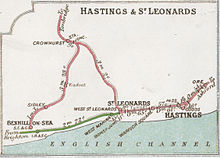 1914 Railway Junction Diagram of Hastings area lines and stations; the Bexhill West branch and the West Marina station have since closed.
1914 Railway Junction Diagram of Hastings area lines and stations; the Bexhill West branch and the West Marina station have since closed.
Hastings has four rail links: two to London, one to Brighton and one to Ashford. Of the London lines, the shorter is the Hastings Line, the former South Eastern Railway (SER) route to Charing Cross via Battle and Tunbridge Wells, which opened in 1852; and the longer is the East Coastway Line, the former London, Brighton and South Coast Railway (LBSCR) route to Victoria via Bexhill, Eastbourne and Lewes. Trains to Brighton also use the East Coastway Line. The Marshlink Line runs via Rye to Ashford where a connection can be made with Eurostar services, and is unelectrified except for the Hastings-Ore segment.
A historic British Rail Class 201 "Thumper" can sometimes been seen (and heard) on historic runs to and from Hastings.[35] This was a regular service from Hastings to Ashford and many locals have fond memories of hearing the trains rumble in and out of Hastings.
Hastings is served by two rail companies: Southeastern and Southern. Southeastern services run along the Hastings Line, generally terminating at Hastings, with some peak services extending to Ore; the other lines are served by Southern, with services terminating at Ore or Ashford.
The town currently has four railway stations: from west to east they are West St Leonards station, St Leonards Warrior Square, Hastings, and Ore; this latter has been proposed to be renamed to Ore Valley.[36] There is also one closed station and one proposed station in the area. West Marina station (on the LBSCR line) was very near West St Leonards (on the SER line) and was closed some years ago. A new station has been proposed at Glyne Gap in Bexhill, which would also serve residents from western Hastings.[36]
Local Rail
There are two funicular railways, known locally as the West Hill and East Hill Lifts respectively.
The Hastings Miniature Railway operates along the beach from Rock-a-Nore to Marine Parade, and has provided tourist transport since 1948. The railway was considerably restored and re-opened in 2010.
A local metro railway service from Bexhill to Ore has also been proposed.[36]
Paths
The Saxon Shore Way, (a long distance footpath, 163 mi (262 km) in length from Gravesend, Kent traces the Kent and Sussex coast “as it was in Roman times” to Hastings. The National Cycle Network route NCR2 links Dover to St Austell along the south coast, and passes through Hastings.
Historical transport systems
Turnpike
Hastings became part of the Turnpike road system in 1837, when builder James Burton was building his new town of St Leonards. The route of the road is that taken by the A21 today.
Trams and trolleybuses
Hastings had a network of trams from 1905 to 1929. The trams ran as far as Bexhill, and were worked by overhead electric wires, except for the stretch along the seafront from Bo-Peep to the Memorial, which was initially worked by the Dolter stud contact system. The Dolter system was replaced by petrol electric trams in 1914, but overhead electrification was extended to this section in 1921. Trolleybuses rather than trams were used in the section that included the very narrow High Street, and the entire tram network was replaced by the Hastings trolleybus system in 1928–1929.[37]
Maidstone and District bought the Hastings Tramway Company in 1935, but the trolleybuses still carried the "Hastings Tramways" logo until shortly before they were replaced by diesel buses in 1959, following the failure of the "Save our trolleys" campaign.
Education
Hastings has 18 primary schools, five secondary schools and one further education college.
University Centre Hastings opened in 2003 and is managed by the University of Brighton, it is located in the town centre a short distance from the train station and the main Sussex Coast College campus. Sussex Coast College, formerly called Hastings College, is the towns further education college. Is located in what is known as the Station Plaza, next to the train station.
The secondary schools in the town include; William Parker Sports College, Helenswood, Hillcrest, Filsham Valley and The Grove. East Sussex County Council has plans to close three mixed comprehensive schools; Filsham Valley, The Grove and Hillcrest, and replace them with two academy schools. The proposed sponsors for the academies are University of Brighton (lead sponsor), British Telecom and East Sussex County Council itself. East Sussex County Council provisionally approved the closure of Hillcrest, the Grove and Filsham Valley in late-November, and has announced that a final decision will be made on the schools' future in January 2010.[38]
Religious buildings
Main article: List of places of worship in HastingsThe most important buildings from the late medieval period are the two churches in the Old Town, St Clement's (probably built after 1377) and All Saints (early 15th century).[39] There is also a Muslim mosque, formerly "Mercatoria School" until purchased by the East Sussex Islamic Association. The former Ebenezer Particular Baptist Chapel in the Old Town dates from 1817 and is listed at Grade II.[40]
Sport
Every year the Hastings Half Marathon is held in the town, the race first took place in 1984 and attracts entrants from all over the country. The 13.1 mi (21.1 km) long race takes runners on a route circling the town, which starts and finishes by the West Marina Gardens in St Leonards.
Hastings United is the town's most senior football team, playing in the Premier Division of the Isthmian League. They were founded in 1894 and play their home games at the Pilot Field. The home used to be home to two other senior clubs; St Leonards and Hastings United, the original club who folded in 1984. There are football clubs in Hastings, who play in the East Sussex League, such as Hollington United, St Leonards Social and Rock-a-Nore, who play at various local parks and recreation grounds around the town.
Hastings Priory is the towns largest cricket club, having 4 teams playing competitive as well as a large junior section. The club's home is at Horntye Park, though they do also use the facilities at William Parker Sports College
William Parker has facilities for a number different sports and see clubs using the school as their base, such as Hastings & Bexhill rugby club, Hastings Athletic Club and Hastings Priory cricket club 3rd and 4th teams. Other local teams include Cinque Ports Rugby Club, who play at the Grove School and South Saxons hockey club who play on the astroturf pitch at Horntye Park.
There are many Bowls greens in the parks and gardens located around the town, the Hastings Open Bowls Tournament has been held annually in June since 1911 and attracts many entrants country-wide.[41]
Notable people
Filmography
- Is Anybody There? (2007)
- Foyle's War[42](TV, 2002 onwards)
- When I Was 12[43]
- The Final Curtain (2000)
- Some Voices (2000)
- Last of the Blonde Bombshells (1999)
- Grey Owl (1999)
- I Want You (1998)
References
Notes
- ^ a b c "Neighbourhood Statistics". Office for National Statistics. http://neighbourhood.statistics.gov.uk/dissemination/LeadAreaSearch.do?a=7&r=1&i=1001&m=0&s=1309271698515&enc=1&areaSearchText=Hastings&areaSearchType=13&extendedList=false&searchAreas=. Retrieved 29 June 2011.
- ^ "Hastings Borough Council". Competitive Hastings. http://www.hastings.gov.uk/business/competitive_hastings.aspx. Retrieved 2009-02-10.
- ^ Eilert Ekwall, The Oxford Dictionary of English Place Names, Oxford University Press 1936.
- ^ Patrick Hanks and Flavia Hodges, The Oxford Names Companion, Oxford University Press 2002. ISBN 0-19-860561-7
- ^ Pamela Combes and Malcolm Lyne,"Hastings, Haestingaceaster and Haestingaport: a question of identity". Sussex Archaeological Collections, 133 (1995), 213–24. ISSN 01438204
- ^ "Beauport Park". History and the Arts. BBC/Open University. http://www.open2.net/historyandthearts/history/locations_beauport_park.html. Retrieved 2008-03-31.
- ^ a b Marchant, Rex (19-06-1905–1 October 1997). Hastings Past. Phillimore & Co Ltd. ISBN 1 86077 046 0.
- ^ "Hithe – the definition of Hithe". The Free Online Dictionary. http://www.thefreedictionary.com/Hithe. Retrieved 2008-03-31.
- ^ a b http://www.historyfiles.co.uk/KingListsBritain/EnglandSussex.htm
- ^ Kirby, Earliest English Kings, p. 124.
- ^ http://www.esawyer.org.uk/content/charter/133.html
- ^ http://www.hastingschronicle.net/771-1699.html
- ^ Challis, Christopher Edgar; I Stewart, NJ Mayhew, GP Dyer, PP Gaspar (1993). "The English and Norman Mints, c. 600–1158". A New History of the Royal Mint. Cambridge University Press. pp. 40. ISBN 9780521240260. http://books.google.co.uk/books?id=Zz89AAAAIAAJ. Retrieved 2008-03-31.
- ^ "Hastings Museum". Smuggling on the Sussex Coast. http://www.hmag.org.uk/LocalHistory/. Retrieved 2009-02-10.
- ^ Seaside History: the Bathing Pool at Hastings and St Leonards
- ^ a b "Map of ward boundaries". Hastings Online. http://www.hastings.gov.uk/wards/default.aspx. Retrieved 2009-02-17.
- ^ "Natural England – SSSI (Marline Valley Woods)". English Nature. http://www.english-nature.org.uk/special/sssi/sssi_details.cfm?sssi_id=1003006. Retrieved 2008-10-06.
- ^ "Natural England – SSSI (Combe Haven)". English Nature. http://www.english-nature.org.uk/special/sssi/sssi_details.cfm?sssi_id=1001853. Retrieved 2008-10-07.
- ^ "Natural England – SSSI (Hastings to Pett Cliffs)". English Nature. http://www.english-nature.org.uk/special/sssi/sssi_details.cfm?sssi_id=1002885. Retrieved 2008-10-05.
- ^ "1911 Sunshine". TORRO. http://www.torro.org.uk/site/sunshine.php.
- ^ "2006 temperature". KNMI. http://eca.knmi.nl/utils/monitordetail.php?seasonid=13&year=2006&indexid=TXx&stationid=1865.
- ^ "1987 Temperature". TORRO. http://eca.knmi.nl/utils/monitordetail.php?seasonid=7&year=1987&indexid=TNn&stationid=1865.
- ^ "Hastings Climate". KNMI. http://eca.knmi.nl/utils/mapserver/anomaly.php?indexcat=**&indexid=TNn&year=1987&seasonid=7&create_image=true&minx=-1111428.5714287&miny=-4687142.8571429&maxx=621904.76190476&maxy=-3387142.8571428&MapSize=560%2C420&imagewidth=560&imageheight=420&mainmap.x=376&mainmap.y=371&CMD=QUERY_POINT&CMD=QUERY_POINT#bottom. Retrieved 11 Nov 2011.
- ^ "Hastings Sunshine". MetOffice. http://web.archive.org/web/20010210223343/http://www.metoffice.gov.uk/climate/uk/averages/sites/30.html. Retrieved 11 Nov 2011.
- ^ "Burton's St Leonards". 1066online. http://www.1066online.co.uk/hastings-history/burtons-st-leonards/burton-st-leonards-history.htm. Retrieved 29 June 2011.
- ^ "Local Development Framework". Hastings Online. http://64.233.183.104/search?q=cache:pGSq1AuoTgkJ:www.hastings.gov.uk/ldf/amr.pdf+Hastings+populationstatistics&hl=en&ct=clnk&cd=5&gl=uk. Retrieved 2009-02-17.
- ^ House of Commons Select Committee: Stakeholders in Hastings 2006
- ^ Peak, Steve (1985). Fishermen of Hastings – 200 years of the Hastings Fishing Community.
- ^ Priory Meadow shops to grow Hastings Observer]
- ^ Hastings Regeneration SEEDA
- ^ Sea Space finalises plans for next Priory Quarter development Sea Space
- ^ Hastings Traditional Jack-in-the-Green
- ^ Hastings Boroughs Bonfire Society
- ^ east Sussex County Council:Bexhill to Hastings link road
- ^ Hastings Diesels
- ^ a b c "ACCESS TO HASTINGS MULTI-MODAL STUDY (Consultation Report)". pp. 324. Archived from the original on 28 October 2007. http://web.archive.org/web/20071028194632/http://www.hastings.gov.uk/access_hastings/a2hfinalreport_appx.pdf. Retrieved 2009-05-09.
- ^ Robert J Harley, Hastings Tramways. Middleton Press 1993. ISBN 1 873793 18 9.
- ^ "Protest opposes school academies". BBC News. 2009-11-24. http://news.bbc.co.uk/1/hi/england/sussex/8375979.stm. Retrieved 2010-05-04.
- ^ Nairn, Ian, and Pevsner, Nikolaus, The Buildings of England: Sussex, Page 119. Penguin, 1965
- ^ "Detailed Record: Ebenezer Particular Baptist Chapel, Ebenezer Road, Hastings, Hastings, East Sussex". Images of England. English Heritage. 2007. http://www.imagesofengland.org.uk/Details/Default.aspx?id=293813&mode=quick. Retrieved 20 April 2010.
- ^ Hastings Open Bowls Tournament
- ^ "Foyle's War". The Internet Movie Database. http://www.imdb.com/title/tt0310455/. Retrieved 2009-02-10.
- ^ "When I Was 12 (2001)". The Internet Movie Database. http://www.imdb.com/title/tt0316892/. Retrieved 2010-05-23.
Bibliography
- Challis, Christopher Edgar; I Stewart, NJ Mayhew, GP Dyer, PP Gaspar (1993). "The English and Norman Mints, c. 600–1158". A New History of the Royal Mint. Cambridge University Press. pp. 40. ISBN 9780521240260. http://books.google.co.uk/books?id=Zz89AAAAIAAJ. Retrieved 2008-03-31.
- Baines FSA, John Manwaring (1963). Historic Hastings. F J Parsons Ltd.
- Peak, Steve (1985). Fishermen of Hastings: 200 Years of the Hastings Fishing Community. Newsbooks. ISBN 0-95107-060-6.
- Marchant, Rex (1997). Hastings Past. Phillimore & Co Ltd. ISBN 1-86077-046-0.
- Winn, Christopher. I Never Knew That About England.
- Down the Line to Hastings Brian Jewell, The Baton Press ISBN 0 85936 223 X
- Robert J Harley, Hastings Tramways. Middleton Press 1993. ISBN 1 873793 18 9.
- Nairn, Ian, and Pevsner, Nikolaus, The Buildings of England: Sussex, Page 119. Penguin, 1965
- Brooks, Ken. Hastings: Then And Now.
External links
- Hastings Borough Council official website
- Hastings and 1066 Country tourist information
- A thorough history of Hastings by local historian Steve Peak
- A Geograph article and photo-record of the area
 Districts of South East England
Districts of South East EnglandBerkshire 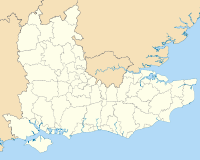
Buckinghamshire Aylesbury Vale • Chiltern • Milton Keynes • South Bucks • Wycombe
East Sussex Brighton and Hove • Eastbourne • Hastings • Lewes • Rother • Wealden
Hampshire Basingstoke and Deane • East Hampshire • Eastleigh • Fareham • Gosport • Hart • Havant • New Forest • Portsmouth • Rushmoor • Southampton • Test Valley • Winchester
Isle of Wight Kent Ashford • Canterbury • Dartford • Dover • Gravesham • Maidstone • Medway • Sevenoaks • Shepway • Swale • Thanet • Tonbridge and Malling • Tunbridge Wells
Oxfordshire Surrey Elmbridge • Epsom and Ewell • Guildford • Mole Valley • Reigate and Banstead • Runnymede • Spelthorne • Surrey Heath • Tandridge • Waverley • Woking
West Sussex Adur • Arun • Chichester • Crawley • Horsham • Mid Sussex • Worthing
Ceremonial county of East Sussex Unitary authorities Boroughs or districts - Borough of Eastbourne
- Borough of Hastings
- District of Lewes
- District of Rother
- District of Wealden
Major settlements Rivers Topics - History
- Geography
- Museums
- Parliamentary constituencies
- Places
- Transport
- South Downs
- North Downs
- Beachy Head
- High Weald
- Long Man of Wilmington
Buildings Hastings Castle · Hastings Fishermen's Museum · Hastings Museum and Art Gallery · Hastings Pier · Priory Meadow Shopping Centre · Stag Inn · White Rock Theatre
Religious Buildings Places of Worship · Christ Church, Ore · Sussex Coast College · Church in the Wood · Ebenezer Particular Baptist Chapel · Holy Trinity Church · St Mary Magdalene's Church · St Leonards-on-Sea United Reformed Church · Christ Church, St Leonards · Church of St Thomas of Canterbury and English Martyrs · St John the Evangelist's Church · St Peter's Church · St Luke's Church · St Matthew's Church
Education Helenswood School · Hillcrest · Sussex Coast College · University Centre Hastings · William Parker Sports College
Sport Transport Roads: A21 · A28 · A259 · A2100
Rail: Hastings railway station · Marshlink Line · Ore railway station · St Leonards Warrior Square railway station · West St Leonards railway station
Areas & Suburbs Bulverhythe · Old Town · Ore Valley · Silverhill · St Leonards-on-Sea
Categories:- Hastings
- East Sussex
- Cinque ports
- Local government in East Sussex
- Seaside resorts in England
- Towns in East Sussex
- Populated coastal places in East Sussex
- Non-metropolitan districts of East Sussex
- Local government districts of South East England
Wikimedia Foundation. 2010.

